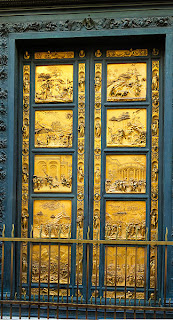Giorgio
Vasari: master biographer. Lorenzo
Ghiberti: master of sculpture. The
two men have both contributed a vast wealth of long lasting culture to the
world - a wealth that has not diminished with time and has only added to our
understanding of the history of mankind and his accomplishments.
 |
| Gates of Paradise, photo courtesy of Wikipedia CC |
Vasari
recounts in his biography of Ghiberti (1378-1455) the exact point at which his
talent was eclipsed into country-wide fame – at his creation of the great
bronze panel for a competition in 1401. Vasari's biographic tale casts a light of perspective onto Ghiberti's prized work. Without background, the Bronze Gates of Paradise are awe striking, but the depth of this accomplishment is not fully understood. In his description of Ghiberti and his competitors, Vasari
recounts that Ghiberti allowed artists and townspeople alike to view and
critique his panel, while his competitors guarded them with secrecy. It was perhaps because of this that his
panel so far surpassed the others.
With great care and consideration, Ghiberti worked and reworked his
panel in wax, finally casting it in Bronze. Vasari allows the humanity behind Ghiberti’s masterpiece to surface with his tale, relating the care and affection both Ghiberti and his father,
Bartoluccio, gave to the panel which depicts the Old Testament story.
Though the doors do not stand in
their original spot at the baptistery, residing only some hundreds of feet away
in the museum of Santa Maria del Fiore Cathedral, they are as wondrous now as they were during the
Renaissance. Though the relief
does not reach more than two inches, some figures stand in almost full relief,
while the architecture and backgrounds protrude less than a centimeter and still
seem to recede with perspective.
The figures themselves seem to sway with movement. Wholly, his mastery with sculpture adds
a dimension of reality to the panels that is not present in the panel of his
competitor, Filippo Brunelleschi.
What is most important about Vasari's biography is its reminder that these Gates of Paradise are not mythical objects, but were created in a specific time, at a specific place. If one stands in front of the doors to the baptistry, one stands where centuries ago, Michelangelo supposedly gave these doors their infamous name.








